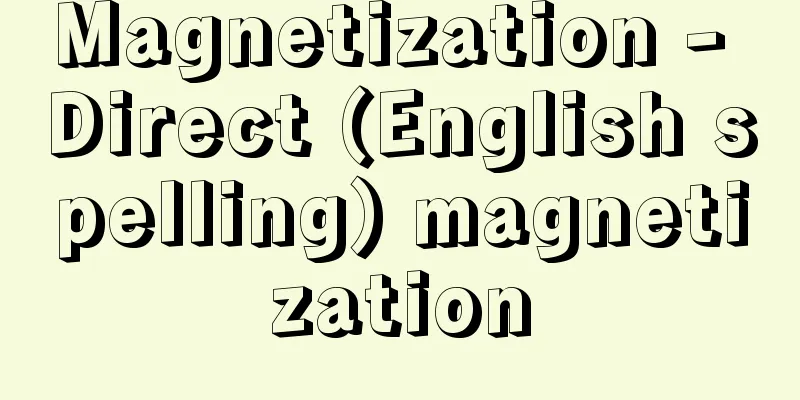Magnetization - Direct (English spelling) magnetization

|
It refers to placing a material in a magnetic field to turn it into a magnet, that is, to give it a magnetic moment, and the magnetic moment per unit volume of the material obtained in this way is also called magnetization (vector). When an unmagnetized material is placed in a magnetic field of strength H , the magnetization of the material is M. For ordinary materials, M is extremely small and can only be measured with a precise instrument, but M is proportional to H. For strongly magnetized materials such as iron (ferromagnetic materials), M is not proportional to H , and as H increases, M saturates and the phenomenon of hysteresis is observed. The ratio of M to H is called the magnetic susceptibility, or sometimes the magnetic susceptibility. When M and H are proportional, this ratio χ is of course constant, but for ferromagnetic materials, χ is a function of the magnetic field. The maximum χ of a ferromagnetic material is called the maximum magnetic susceptibility. χ varies depending on the material and also changes with temperature. For ferromagnetic materials such as iron at room temperature, χ can take values of several tens or several hundreds of thousands, but for many materials it is small, about one millionth of a second, and can be positive or negative. In single crystals of ferromagnetic materials, there are directions in which magnetization is particularly easy. For example, in iron single crystals, the Miller index chi for the (100) direction is large. This is called the easy magnetization direction. When examined closely, it has become clear that small regions of ferromagnetic materials are actually magnetized spontaneously, without the aid of an external magnetic field, and this magnetization is called spontaneous magnetization. Ordinarily, magnetizing iron or other materials involves aligning the magnetization directions of small regions that are pointing in different directions into one direction, and this is sometimes called technical magnetization to distinguish it from spontaneous magnetization. Traditionally, magnetization was measured using a device called a magnetic balance, which measures the force an object receives in a non-uniform magnetic field. From around the latter half of the 1980s, magnetometers using SQUIDs (superconducting quantum interference devices) became widespread, making it possible to measure the magnetization of minute samples with extremely high sensitivity. SQUIDs are devices that utilize the Josephson effect, and can count the number of magnetic fluxes that pass through the device. [Shohei Miyahara and Hirohiko Sato] "Magnetic Materials - Physical Properties, Engineering Characteristics and Measurement Methods" edited by Hiroshi Shimada and Koji Yamada (1999, Kodansha) " "Introduction to Electronic Properties" by Tomohiro Hamaguchi (1999, Maruzen) [References] | | |Source: Shogakukan Encyclopedia Nipponica About Encyclopedia Nipponica Information | Legend |
|
物質を磁場の中に置いてそれを磁石にすること、つまり磁気モーメントを与えることをいうが、またそのようにして得られたその物質の単位体積当りの磁気モーメントも磁化(ベクトル)という。 磁化されていない物質を、強さがHの磁場の中に入れたとき、その物質の磁化はMとなり、普通の物質ではMはきわめて小さく精密な計器でないと測れないが、MはHに比例する。鉄などのように強く磁化されるもの(強磁性体)ではMはHに比例せず、Hが大きくなるとMは飽和し、またヒステリシスの現象がみられる。MとHとの比を磁化率とよび、また帯磁率とよぶこともある。MとHとが比例するときにはもちろんこの比χは一定であるが、強磁性体ではχは磁場の関数である。ある強磁性体の最大のχを最大磁化率という。χは物質によって異なり、また温度によっても変化する。室温で強磁性体である鉄などではχは数十ないし数十万の値をとるが、多くの物質では100万分の1程度の小さなものであり、正のもののほか負のものもある。 強磁性体の単結晶ではとくに磁化しやすい方向がある。たとえば鉄単結晶では、ミラー指数の(100)方向のχが大きい。これを磁化容易方向という。微細に調べると強磁性体は、実は小さな領域ごとに、外部の磁場によらずに自発的に磁化していることが明らかにされ、その磁化を自発磁化という。普通に鉄などを磁化するというのは、ばらばらの方向を向いている小領域の磁化方向を一方向にそろえることであって、これをとくに技術磁化とよんで自発磁化と区別することもある。 磁化の測定は、古くは不均一な磁場中で物体が受ける力を測定する磁気天秤(てんびん)という機器で行われていた。1980年代後半ごろからは、SQUID(スキッド)(超伝導量子干渉素子)を用いた磁束計が普及し、微小試料の磁化をきわめて高感度で測定できるようになった。SQUIDは、ジョセフソン効果を応用した素子であり、素子を貫く磁束の数を数えることができる。 [宮原将平・佐藤博彦] 『島田寛・山田興治編『磁性材料――物性・工学的特性と測定法』(1999・講談社)』▽『浜口智尋著『電子物性入門』(1999・丸善)』 [参照項目] | | |出典 小学館 日本大百科全書(ニッポニカ)日本大百科全書(ニッポニカ)について 情報 | 凡例 |
<<: Ego - Jiga (English spelling) self
Recommend
Defense of simultaneous performance
In the case of a bilateral contract, one party ma...
Blue ticket - Aogippu
〘 noun 〙 (Because the ticket was light blue) Origi...
Ugashi
...A town in Uda County, central eastern Nara Pre...
Open cut method - Open cut method (English)
This method utilizes the stable gradient of the so...
Cover - Cover
This refers to the slight photographic density th...
Uchidori Village - Utoumura
…It is a tourist base for Towada-Hachimantai Nati...
Legendary Song - Densetsuka
A common name for a group of poems that appear in ...
Mount Yoshino
<br /> A mountain range in Yoshinoyama, Yosh...
Castor bean - Castor bean (English spelling)
Also known as castor bean (illustration). A woody ...
Callichthyidae
...Several species have been imported to Japan as...
Helmont, Jan Baptista van
Born: January 12, 1580, Brussels [Died] December 3...
Libytheidae
…In some places, they can appear in large numbers...
Carmilla
...This is why a man-eater or a seductress is cal...
Clematis tosaensis (English spelling) Clematistosaensis
…[Michio Tamura]. … *Some of the terminology that...
Gandhi-Irwin Agreement
…In the process, he also skillfully integrated th...






![Yugawara [town] - Yugawara](/upload/images/67cd1308ba6eb.webp)


